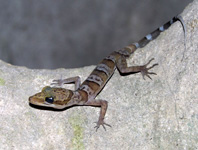Abstract
A new species of Sarcophagidae, Peckia (Peckia) veropeso sp. nov., is described based on adult male specimens collected on organic residues in an urban open air market located on the riverside in Belém, Pará state, Brazil, and in a nearby inundated forest. This species seems to be restricted to periodically inundated riparian habitats locally known as “várzea”. The distiphallus of this species is similar to that of members of the monophyletic hilifera (Aldrich)-group in the subgenus Peckia Robineau-Desvoidy. It is distinguished from the other species in the subgenus by characteristics of the male terminalia, mainly in the shape of cercus and vesica. A modified key to species of the subgenus Peckia is included.
References
Barbosa, T.M., Mello-Patiu, C.A. & Vasconcelo, S.D. (2013) Flesh fly (Diptera: Sarcophagidae) survey on coastal environments in northeastern Brazil: new records and notes on the expanded geographical distribution. Entomotropica, 30, 112–117.
Buenaventura, E. & Pape, T. (2013) Revision of the New World genus Peckia Robineau-Desvoidy (Diptera: Sarcophagidae). Zootaxa, 3622 (1), 1–87.
http://dx.doi.org/10.11646/zootaxa.3622.1.1Buenaventura, E. & Pape, T. (2015) Phylogeny of the Peckia-genus group: evolution of male genitalia in the major necrophagous guild of Neotropical flesh flies (Diptera: Sarcophagidae). Organism Diversity and Evolution, 15, 301–331.
http://dx.doi.org/10.1007/s13127-015-0203-0Carvalho, C.J.B, Rafael, J.A., Couri, M.S. & Silva, V.C. (2012) Diptera Linnaeus, 1758. In: Rafael, J.A., Melo, G.A.R., Carvalho, C.J.B., Casari, S.A. & Constantino, R. (Eds.), Insetos do Brasil: Diversidade e taxonomia. Holos Editora, Riberão Preto, pp. 347–405.
Cumming, J.M. & Wood, D.M. (2009) Adult morphology and terminology. In: Brown, B.V., Borkent, A., Cumming, J.M., Wood, D.M., Woodley, N.E. & Zumbado, M. (Eds.), Manual of Central American Diptera. Vol. 1. NRC Research Press, Ottawa, pp. 9–50.
Czech, B., Krausman, P.R. & Devers, P.K. (2000) Economic associations among causes of species endangerment in the United States. BioScience, 50, 593–601.
http://dx.doi.org/10.1641/0006-3568(2000)050[0593:EAACOS]2.0.CO;2d’Almeida, J.M. (1988) Substratos utilizados para a criação de dipteros caliptratos em uma área urbana do município do Rio de Janeiro. Memórias do Instituto Oswaldo Cruz, 83, 201–206.
http://dx.doi.org/10.1590/S0074-02761988000200009Dodge, H.R. (1965) The Sarcophagidae (Diptera) of the West Indies. I. The Bahama Islands. Annals of the Entomological Society of America, 58, 474–497.
http://dx.doi.org/10.1093/aesa/58.4.474Esposito, M.C. & Linhares, A.X. (2002) Califorídeos e outros muscóides da Estação Científica Ferreira Penna. In: Lisboa, P.L.B. (Ed.), Caxiuanã populações tradicionais. Meio físico e diversidade biológica. Museu Paraense Emílio Goeldi, Belém, pp. 579–585.
Feinberg, J.A., Newman, C.E., Watkins-Colwell, G.J., Schlesinger, M.D., Zarate, B., Curry, B.R., Shaffer, H.B. & Burger, J. (2014) Cryptic diversity in metropolis: confirmation of a new leopard frog species (Anura: Ranidae) from New York City and surrounding Atlantic Coast regions. PloS One, 9, e108213.
http://dx.doi.org/10.1371/journal.pone.0108213Giroux, M., Pape, T. & Wheeler, T.A. (2010) Towards a phylogeny of the flesh flies (Diptera: Sarcophagidae): morphology and phylogenetic implications of the acrophallus in the subfamily Sarcophaginae. Zoological Journal of the Linnean Society, 158, 740–778.
http://dx.doi.org/10.1111/j.1096-3642.2009.00561.xHartop, E.A., Brown, B.V. & Disney, R.H.L. (2015) Opportunity in our ignorance: urban biodiversity study reveals 30 new species and one new Nearctic record for Megaselia (Diptera: Phoridae) in Los Angeles (California, USA). Zootaxa, 3941 (4), 451–484.
http://dx.doi.org/10.11646/zootaxa.3941.4.1Lopes, H.S. (1973) Notes on some Neotropical Sarcophagidae studied by H. R. Dodge (Diptera). Anais da Academia Brasileira de Ciências, 45, 293–299.
McKinney, M.L. (2008) Effects of urbanization on species richness: a review of plants and animals. Urban Ecosystems, 11, 161–176.
http://dx.doi.org/10.1007/s11252-007-0045-4Mulieri, P.R., Patitucci, L.D., Schnack, J.A. & Mariluis, J.C. (2011) Diversity and seasonal dynamics of an assemblage of sarcophagid Diptera in a gradient of urbanization. Journal of Insect Science, 11 (91), 1–15.
http://dx.doi.org/10.1673/031.011.9101Pape, T., Blagoderov, V. & Mostovski, M.B. (2011) Order Diptera Linnaeus, 1758. In: Zhang, Z.Q. (Ed.), Animal biodiversity: An outline of higher-level classification and survey of taxonomic richness. Zootaxa, 3148, 222–229.
Pires, J.M. & Prance, G.T. (1985) The vegetation types of Brazilian Amazon. In: Prance, G.T. & Lovejoy, T.E. (Eds.), Key environments: Amazonia. Pergamon Press, Oxford, pp. 109–145.
Sousa, J.R.P., Esposito, M.C. & Carvalho Filho, F.S. (2011) Composition, abundance and richness of Sarcophagidae (Diptera: Oestroidea) in forests and forest gaps with different vegetation cover. Neotropical Entomology, 40, 20–27.
http://dx.doi.org/10.1590/S1519-566X2011000100003

